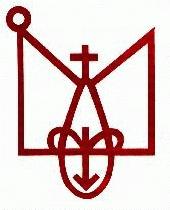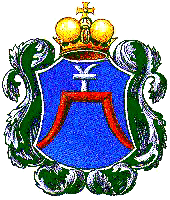
Coats of arms
of Belarusan houses
In ancient Slavonic and other societies the predecessors of national
crests were family emblems and symbols which occurred on various objects
to mark their owner. At the time of the Kievan Rus (9th - 11th c.) the
feudal lords used the image of a trident, possibly the stylization of an
eagle.

An emblem of Iziaslau Uladzimiravic, Prince
of Polack (980-1001)
Coats of arms in their traditional form (a knight's shield) appeared in
Belarus in the 14th-15th century and spread quickly, especially after
the union with Poland in 1413, when the 47 most significant families of
the Belarusian gentry were granted their own coats of arms. Such coats
of arms were often orientated to European heraldic traditions. The
influence of French, German and particularly Polish heraldry was
noticable. Later local subjects were also introduced into many coats of
arms.
Apart from the basic element, the shield, coats of arms consisted of
numerous additional elements. The crests of temporal lords (knights,
counts or members on the gentry) had a crown on top, whereas those of
members of the clergy contained church symbols (such as a mitre, for
example). In addition there were often banners and weapons in the
margin.

Coat of arms of Ahinski House
After Belarus became part of Russia at the end of the 18th century, not
only the Belarusian gentry but also other old families had to give up
their titles and lost the right to their family crests. Sometimes their
descendants had to struggle for decades with all the authorities from
Minsk to St. Petersburg to get their rights back. Many of them did not
succeed.
After the October Revolution of 1917 the Soviet authorities passed a
special decree which declared all rights to particular coats of arms
forfeited.
Go to Belarusan heraldry main page |
History of Belarus |
Virtual Guide to Belarus
 This file is a part of the Virtual Guide to
Belarus - a collaborative project of Belarusian
scientists and professionals abroad. VG brings you the most extensive
compilation of the information about Belarus on the Web.
This file is a part of the Virtual Guide to
Belarus - a collaborative project of Belarusian
scientists and professionals abroad. VG brings you the most extensive
compilation of the information about Belarus on the Web.
Please send your comments to the authors of
VG to Belarus 
History
| Statehood | Culture
| Law and Politics | Cities
| Nature and Geography
| Travel
| Global Resources
| Dictionaries
| Chernobyl | Genealogy
| Industry
 VG to Belarus
VG to Belarus
Disclaimer




 This file is a part of the Virtual Guide to
Belarus - a collaborative project of Belarusian
scientists and professionals abroad. VG brings you the most extensive
compilation of the information about Belarus on the Web.
This file is a part of the Virtual Guide to
Belarus - a collaborative project of Belarusian
scientists and professionals abroad. VG brings you the most extensive
compilation of the information about Belarus on the Web.